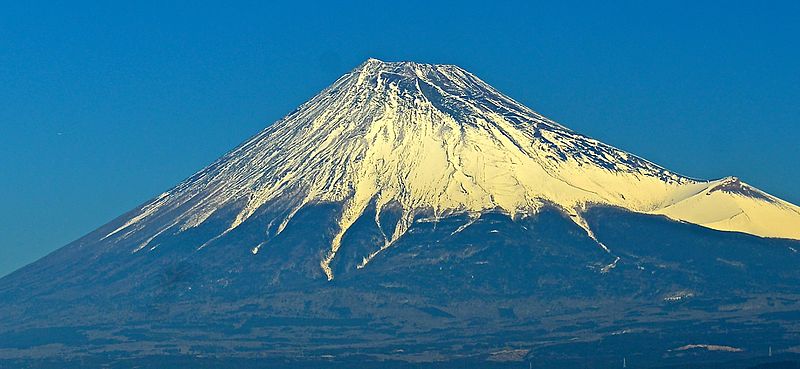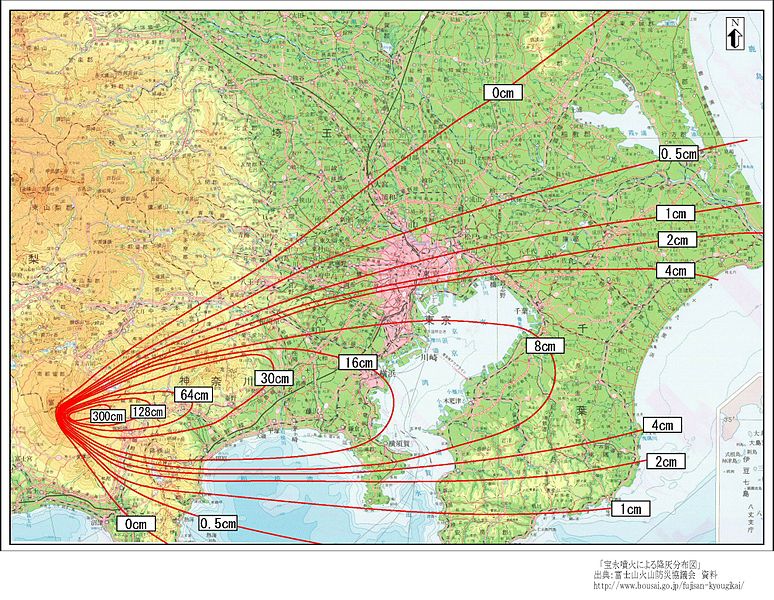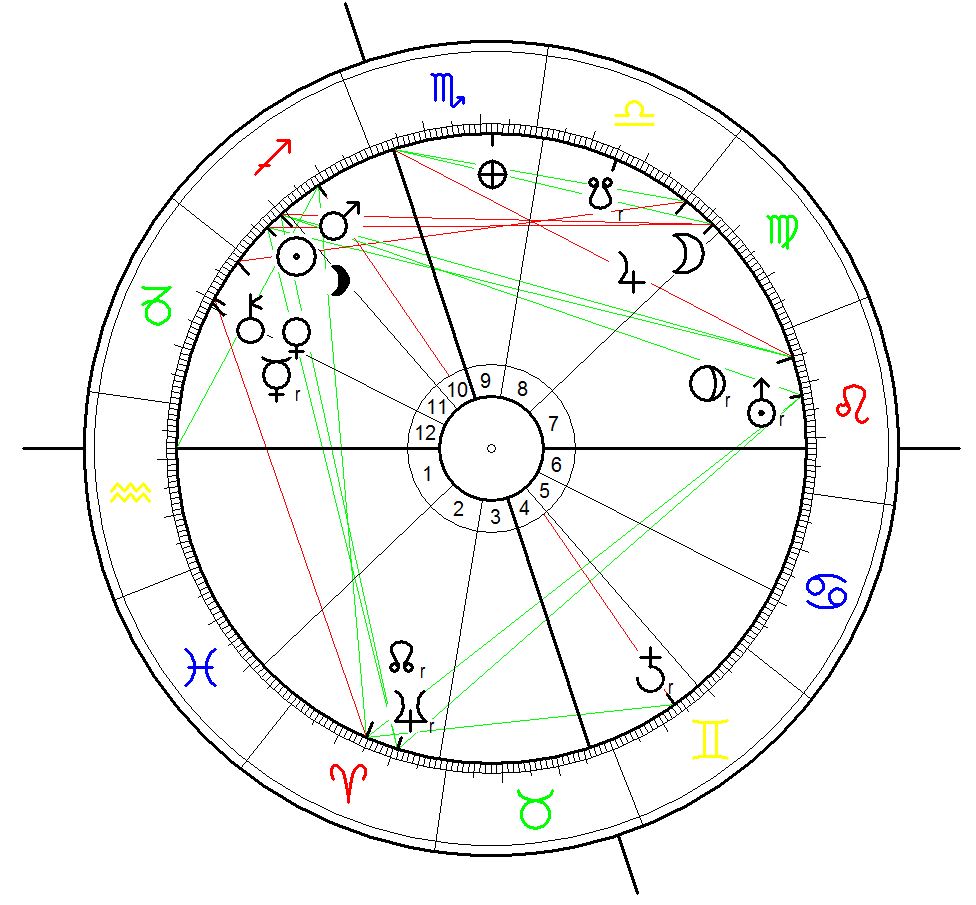Astrology and Magical Places: Mount Fuji in astrogeography
Mount Fuji is a 3,776 m active stratovolcano. It is the highest mountain in Japan and the holy mountain of Honshu. Like Mt Taranaki in New Zealand the shape of the cone of Mt. Fuji is ideally symmetrical and therefore has been used for the filming of “The Last Samurai“. In both cases the crater at the summit area lies directly near the cardinal divide of air sign Libra the sign of symmetry. Compare: The Beauty of Mt Taranaki.

Astrogeographical position for morphogenetical field level 3 which describes how the peak area is embedded in the whole of the mountain range: one coordinate of the 680 m diameter summit crater lies directly near the cardinal divide at 0° of air sign Libra the sign of symmetry pointing at the importance of the mountain as a weather divide, Libra`s qualities are: sign of harmony, balance, angels, beauty, symmetry, decoration & exposed landmarks. The second coordinate of the summit crater falls on the divide between creative, innovative, spiritual air sign Aquarius the sign of the sky, heaven, paradise, self-finding, ascension, flying and reconnection with the spiritual plane and mystic spiritual water sign Pisces the sign of imagination, dreaming, legends, fairy tales, mystification, the spiritual plane itself and the most important indicator for temple sites. The combination of the two spiritual signs is an important hint at an energetical situation that provides everything that can be expected of a holy place, seat of the gods and place of contact with the higher and highest self.
Astrogeographical position for morphogenetical field level 1 which shows how Mt Fuji`s location appr. 100 km west of the Tokyo metropolitain region is embedded in the larger region on the south coast of Honshu: The strong impact of volcanic activity in the region which in is discharged by Mt Fuji can be explained by the fact that one coordinates of the area lies right near the center of highly stable, solid water sign Scorpio (20° Scorpio astrogeographic latitude) the sign of the fire of water and the underworld and as such an indicator for particularly solid underground magma chambers. Scorpio is typical for such areas and regions. Scorpio indicates rock formations that are stable enough to amount much pressure leading to a particularly intense discharge of lava through the volcanoes. Scorpio is a major astrogeographical factor for such archipelagos as Japan created through volcanic acticity. The home of the volcanic goddess Pele in the region west of Mt. Kīlauea in hawaii has both coordinates in Scorpio too.
The coordinate for the astrogeographical longitude of Mt. Fuji lies at 14° in self-protective earth sign Virgo the sign of reason, health, medecine, haeling, psychology, protection of nature and plants, yoga and monk culture and together with Scorpio and Capricorn an important resonator of particular aspects of Japanese culture.
The last eruption occurred during a Mars-Saturn opposition plus a Uranus Pluto cojunction exactly square to the astrogeographic positions of Mt Fuji
The Hōei Eruption of Mount Fuji started on 16 December 1707 at 10:00 a.m. (data source) and ended about 1 January 1708. Although it brought no lava flow, the Hōei eruption released some 800 million cubic metres of volcanic ash, which spread over vast areas around the volcano, even reaching Edo almost 100 kilometres (60 mi) away.

The Event Chart
A serious interpretation of the event chart should differentiate between the causes represented by the movements of the slow-moving outer planets plus Saturn and the triggering factors as indicated by the faster moving planets. The Moon as the fastest moving astrological factor and the relationship of the Sun and Moon as the factors with the strongest gravitational effects are the most important indications in volcanic eruptions and earth quakes to be examined.

The eruption began with the Moon at 23° Virgo in exact square and extreme tension to the Sun at 23° Sagittarius. In Doebereiner astrology both degrees – 23° Sagittarius as well as 23° Virgo are explained as positions of extreme violence and eruption of tensions in event charts as well as in rythmical triggering. The quality of these degrees is related to Uranus-Pluto aspects. And as the ruler of Leo the Sun is the significator of the Uranus – Pluto conjunction in Leo here – pointing at this highly explosive constellation as a major cause for the eruption. This is supported also by the exact square of the 2 planets to the astrogeographical position of Mt Fuji`s volcanic pipe.
Mars – Saturn opposition in a square to 14° Virgo
At the time of the last eruption of Mt. Fuji Saturn had been transiting 14°Gemini the square to the astrogeographic position of Mt. Fuji on 14° Virgo since July 1707 indicating strong tectonic pressure onto the magma chambers below the area over a period of 5 months. The eruption came at a moment when retrograde Saturn at 13° was put under intense pressure through Mars at 11°21 Sagittarius nearing the opposition degree to Mt. Fuji`s astrogeographical longitude. Saturn`s transits are so important also because of his rulership of earth sign Capricorn the sign of the hardest rock material and as such the first indicator for tectonic plates and the pressure exerted by their movements.
The chart for the exact moment of the erruption shows Venus together with a Mercury-Chiron conjunction in Saturn`s home sign Capricorn in house 12 the sphere of instability and destabilization. This constellation suggests pressure from destabilized moving (Mercury) material (Chiron, Venus) in the east of Mt Fuji`s volcanic pipe. At the same time Saturn in house 4 indicates effects of tectonic pressure from below (house 4) the volcanic pipe (IC-MC axis). Mars in confrontation (opposition) to the forces symbolized by Saturn was in Sagittarius the most important indicator for magma indicating that Magma was pressed upwards through the volcanic pipe not directly towards midheaven (MC) but in a direction east of midheaven (house 11). Midheaven itself as ruled by Scorpio the indicator for particularly hard rock and closed up spaces added to the pressure within the volcanic pipe.
Uranus – Pluto conjunction in a square to 21° Scorpio
The conjunction of Uranus at 17°41 with Pluto at 24°48 with midpoint at 21° of fire sign Leo another important indicator for magma square to Mt Fuji also indicates an extreme form and amount of pressure exerted onto the material below Mt. Fuji. As the rulers of the Ascendant and the MC the conjunction of these two planets provides the definition for the main causes for the discharge of pressure through the eruption. This is also strongly emphasized through the accuracy of their transits in relation to the astrogeographic position of Mount Fuji. As both are slow moving planets the forces that they stand for must have been effective for a longer period of about 2 1/2 years or so.